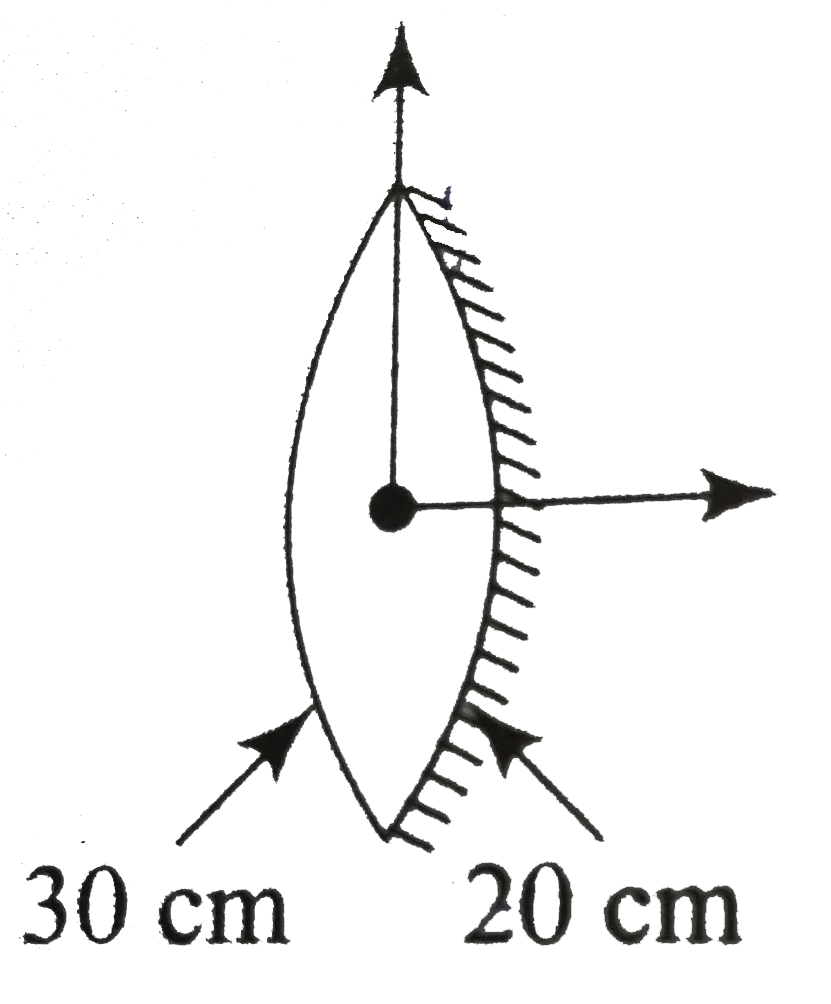A plane convex lens has a focal length 12cm and is made up of glass with refractive index 1.5. Find the radius of curvature of its curved side.
To solve the problem of finding the radius of curvature of the curved side of a plane convex lens with a focal length of 12 cm and a refractive index of 1.5, we can follow these steps:
1. Understanding the Lens:
- A plane convex lens has one flat surface and one curved surface. The curved surface will have a radius of curvature, which we will denote as R1. The flat surface can be considered to have an infinite radius of curvature, denoted as R2=∞.
2. Using the Lens Maker's Formula:
- The lens maker's formula relates the focal length f of the lens to the radii of curvature and the refractive index μ:
1f=(μ−1)(1R1−1R2)
- Here, μ=1.5, f=12cm, and R2=∞.
3. Substituting Values:
- Since R2=∞, we have 1R2=0. Thus, the equation simplifies to:
1f=(μ−1)1R1
4. Calculating μ−1:
- Calculate μ−1:
μ−1=1.5−1=0.5
5. Substituting into the Formula:
- Now substitute f and μ−1 into the equation:
112=0.5⋅1R1
6. Solving for R1:
- Rearranging gives:
1R1=112×0.5=16
- Therefore, taking the reciprocal gives:
R1=6cm
Final Answer:
The radius of curvature of the curved side of the lens is R1=6cm.
- A plane convex lens has one flat surface and one curved surface. The curved surface will have a radius of curvature, which we will denote as R1. The flat surface can be considered to have an infinite radius of curvature, denoted as R2=∞.
- The lens maker's formula relates the focal length f of the lens to the radii of curvature and the refractive index μ:
1f=(μ−1)(1R1−1R2)
- Here, μ=1.5, f=12cm, and R2=∞.
- Since R2=∞, we have 1R2=0. Thus, the equation simplifies to:
1f=(μ−1)1R1
- Calculate μ−1:
μ−1=1.5−1=0.5
- Now substitute f and μ−1 into the equation:
112=0.5⋅1R1
- Rearranging gives:
1R1=112×0.5=16
- Therefore, taking the reciprocal gives:
R1=6cm
The radius of curvature of the curved side of the lens is R1=6cm.
Topper's Solved these Questions
- BOOK - VMC MODULES ENGLISHCHAPTER - RAY OPTICS EXERCISE - Example21videos
RAY OPTICS
- BOOK - VMC MODULES ENGLISHCHAPTER - RAY OPTICS EXERCISE - PRACTICE EXERCISE-11videos
RAY OPTICS
- BOOK - VMC MODULES ENGLISHCHAPTER - QUIZEXERCISE - PHYSICS30videos
QUIZ
- BOOK - VMC MODULES ENGLISHCHAPTER - RAY OPTICS AND WAVE OPTICS EXERCISE - IMPECCABLE58videos
RAY OPTICS AND WAVE OPTICS
Similar Questions
A plano-concave lens is made of glass of refractive index 1.5 and the radius of curvature of its curved face is 100 cm. What is the power of the lens?
View SolutionA plano convex lens is made of glass of refractive index 1.5. The radius of curvature of its convex surface is R. Its focal length is
View Solution
Knowledge Check
- Question 1 - Select One
A double convex lens is made of glass of refractive index 1.55 with both faces of same radius of curvature. Find the radius of curvature required, if focal length is 20cm.
A11cmB22cmC7cmD6cm
A convex-concave diverging lens is made of glass of refractive index 1.5 and focal length 24 cm. radius of curvature for one surface is double that of the other. Then radii of curvature for the two surfaces are (in cm )
View SolutionA double convex lens is made of glass of refractive index 1.55 with both faces of same radius of curvature. Find the radius of curvature required, if focal length is 20cm.
View SolutionA double convex lens is made of glass of refractive index 1.55 with both faces of same radius of curvature. Find the radius of curvature required, if focal length is 20cm.
View SolutionA convexo-concave convergent lens is made of glass of refractive index 1.5 and focal length 24cm. Radius of curvature for one surface is double than that of the other. Then,radii of curvature for the two surfaces are (in cm)
View SolutionA biconvex lens is made of glass with refractive index 1.5 and has radii of curvature 20 cm and 30 cm. If the 20 cm surface is silvered, what is the effective focal length of the mirror formed?
 View Solution
View SolutionA concavo-convex lens is made of glass of refractive index 1.5. The radii of curvature of its two surfaces are 30cm and 50cm. Its focal length when placed in a liquid of refractive index 1.4 is
View SolutionThe two surfaces of a biconvex lens has same radii of curvatures . This lens is made of glass of refractive index 1.5 and has a focal length of 10 cm in air. The lens is cut into two equal halves along a plane perpendicular to its principal axis to yield two plane - convex lenses. The two pieces are glued such that the convex surfaces touch each other. If this combination lens is immersed in water (refractive index =43 ), its focal length (in cm ) is
View Solution

